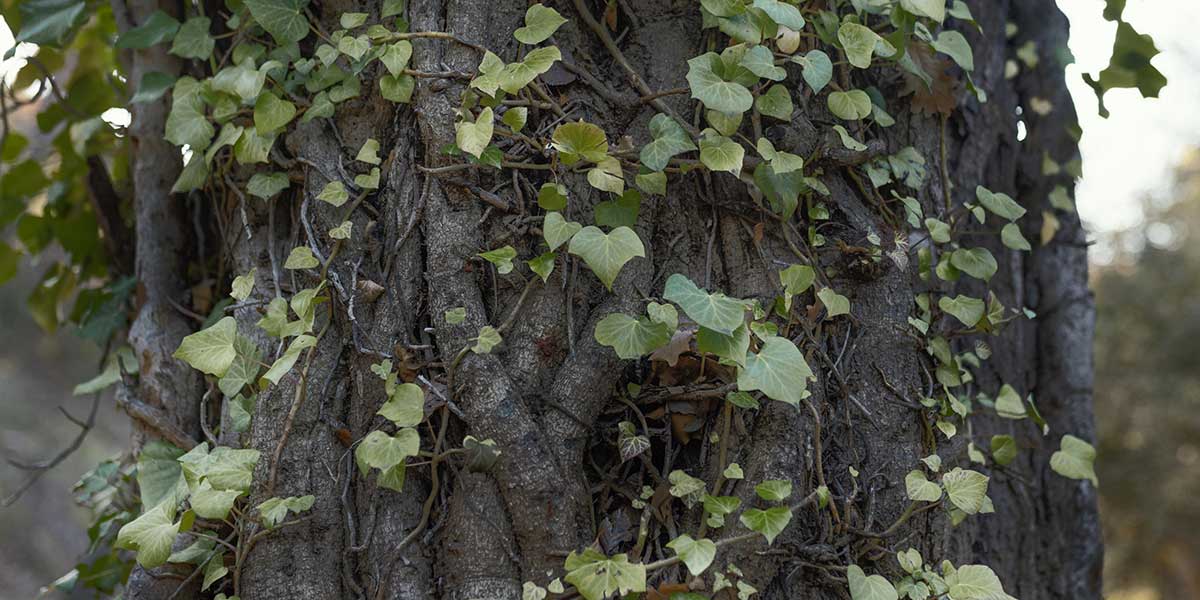If your backyard is starting to look like the set of a jungle Sci-Fi film, you might be asking yourself, are vines bad for trees? In most cases, they are – vines block sunlight, trap moisture, and slowly weaken the tree they’re climbing.
Below, you’ll learn which vine species are common in Woodbury and how they damage your trees. If you’d like some help removing vines or scheduling other tree services in Woodbury, CT, call GM 2 Tree Services, LLC. at (860) 940-5783.

Vine Species in Woodbury, CT
Here’s the question: “Are vines bad for trees?” Before you learn the answer, it’s important to understand the common species that grow around Woodbury.
For example:
- English ivy spreads fast and clings tightly, which damages the tree bark.
- Oriental bittersweet smothers branches and spreads aggressively.
- Wisteria strangles the trunk as it thickens.
- Virginia creeper is native but traps moisture and hides other growth.
- Poison ivy causes skin reactions and makes tree work hazardous.
All of these native and invasive vines take over quickly. If left alone, vines lead to serious tree health problems, which we cover below.
Different Types of Damage Caused by Vines
What are the different ways vines damage your trees? Here are the most prevalent problems of vines on trees.
Extra Weight To Bear Snaps Tree Branches and Limbs
Structural damage is one reason people ask, “Are vines bad for trees?” Vines spread and thicken as they mature, so they easily become wet and heavy during storms. All that extra weight on weak points across the canopy means limbs bend, crack, and fall.
The trunk may also lean or split under the vine’s burden. Damaged structures quickly become unstable. These trees are dangerous, especially near homes, vehicles, fences, and utility lines.
Dense Vine Growth Blocks the Tree’s Sunlight
Are vines bad for trees? One clear reason experts say yes is the loss of tree canopy coverage. As vines climb above the natural crown, their thick leaves block sunlight from reaching the limbs below, so the canopy shrinks, and the tree loses strength.
Without enough light, photosynthesis slows down, and the tree sheds those limbs to save energy. A reduced canopy will mean fewer healthy branches, less growth, and greater exposure to pests, disease, and storm damage.
Roots Compete for Soil Nutrients and Water
Nutrient competition begins underground, where vines and trees share the same root zone. Fast-growing vines absorb water and minerals quickly, leaving the tree with less support. The roots work harder to keep up but fall behind over time.
Stress starts to show in the tree’s leaves and bark – growth slows, limbs thin out, and new shoots struggle to develop. A tree planted in poor soil while competing with invasive vine roots will weaken quickly.
Mold and Rot Collect Under Vines
Is the vine covering bark and trapping water near the trunk? That kind of moisture retention becomes a serious issue for a tree.
Damp conditions create the perfect place for molds or fungi. Insects follow quickly when soft, wet bark begins to rot. Hidden moisture also makes it harder to spot early signs of decay, so an unpracticed eye may not notice the structure weakening until it’s too late. Removing the vine is essential.
Don’t Wait To Get Professional Vine Removal From GM 2 Tree Services, LLC.
Are vines bad for trees in Woodbury, CT? Yes, these life-sucking plants are bad for trees in any location as they block sunlight, trap moisture, and drain nutrients from the soil. Tree health decline is inevitable, so schedule expert vine removal from GM 2 Tree Services, LLC. by calling (860) 940-5783!
Does your tree look stressed after vine removal? Check out our essential tree care tips.

